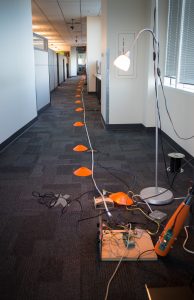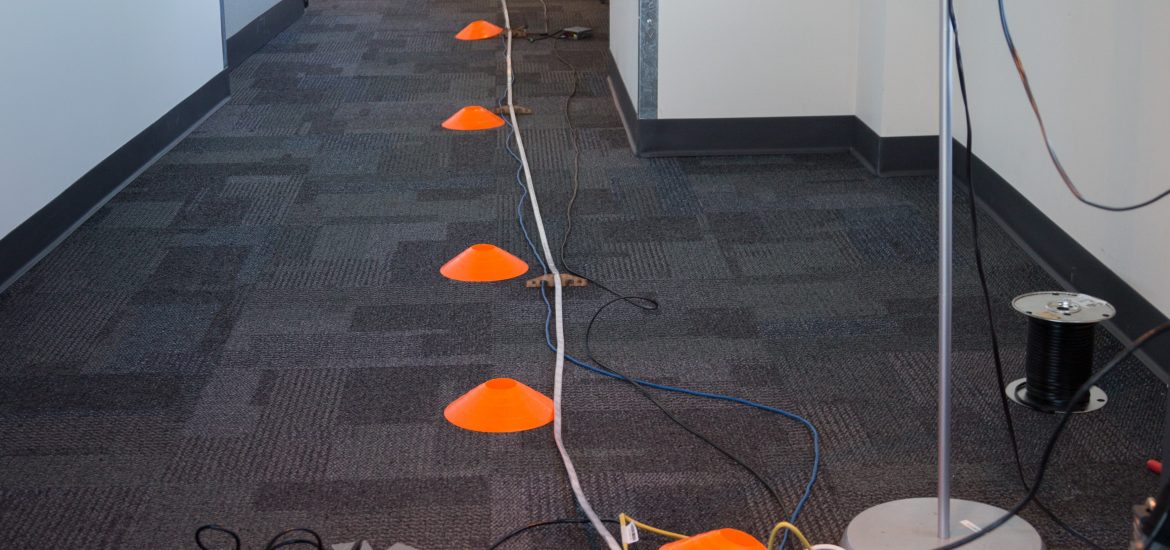 For my first official playtest I set the game up in a hallway at work and invited my students to give it a try.
For my first official playtest I set the game up in a hallway at work and invited my students to give it a try.
My Goals
- Learn what’s involved in installing and breaking down the hardware.
- Use just the basic one and two player rally game to see if people understand it enough to play, and what instructions are necessary.
- Test if the swing speed and swing timing feel comfortable to people.
- Fish for other feedback.
The game was set up for about five hours and 13 people played it. I recorded in-game timing data from 150 rallies. End to end the game was 30 meters long, or about 100 feet, with 900 LEDs. I bought small cones (meant mostly for setting up soccer games) to alert people to be careful about their steps.
Before talking about lessons learned, here’s a video of me playing it in single player mode right after setting the game up, and two players in rally mode.
Lessons Learned
Setup / Breakdown
It took me 1 1/2 hours to set it all up. I think I could do it in about half an hour if I was more prepared. The two things that took the longest time were setting up all the LED strip holders / cable management pieces, and running the power. The next longest part was unrolling the LED strips from their reels.
I anticipated either strong down lighting from the hall lights, or a drop ceiling that I could easily attach a flashlight to to provide the light source for the optical swing timing sensor. The location had neither. I used a boom mic stand for one flashlight and a standing lamp for the other light source. I took a long time to find those solutions.
I didn’t bring my own screwdrivers for attaching the wiring, and couldn’t find the ones we normally have in the office.
Breakdown took about 25 minutes.
Improvements:
- I hadn’t assembled all my 120v power lines before installation, and it took me much longer than I anticipated to make them. Now that I have them this will go faster in the future. There was a 5V 10A power supply every 10 meters that needed power, and it had to run 5V to a strip junction next to it, and a junction 5 meters away.
- I’m redesigning the strip holders to be simpler than my current design. In particular, the slot for the strips is too narrow at the top and I have to bend the strips to get them inserted. In addition to being time consuming, it is also a mechanical stress on the semi delicate LEDs. The new design will not stress the LEDs, be faster to assemble, and I’m hoping to incorporate the cones into the LED holders. It was clear the cones were a good safety addition.
- I don’t have a better solution for storing the LED strips than the reels they came on. I may make new sturdier reels, but they are safest rolled up. I will be reworking the power and signal plugs at both ends of each strip to get rid of excess wires.
- Obvious lesson I’m embarassed to learn again: always take all the tools you’ll need with you.
Player Onboarding and Set Up
People understood very quickly how to play because it looks like many familiar racket sports, but with bats. They had a difficult time finding where to swing to interrupt the light source from the standing lamp because it was coming in at an angle; the other end with a flashlight on a boom mic stand was easier to use.
When switching between games the player has to push a button on the controller to establish the communications mode. This didn’t happen often.
Improvements:
- I’m going to get two boom mic stands to hold the light sources. That solution worked well.
- If all the games use the same communications mode, then pushing the button on the controller won’t be necessary. If it is necessary, a “Start” label on the button might be enough.
Game Play
Lesson 1:
Players got very frustrated when they thought they should have hit the ball but it counted as a miss. The code currently is generous about letting the player swing early, but does not count it if you swing late. People swing late a lot. Slow balls are also really hard to time right.
I’m changing the code to be generous with late swings, too. If you consider a bell curve around the proper timing of a hit, players are only successful for half the bell curve, and they need to be successful on both sides. I’ll have to retest to see how wide the swing window should be.
Lesson 2:
Need to keep working on how much drag the ball should have (so it slows down over time), and how quickly it should die if it won’t make it to the other end. I implemented drag so slow balls would slow down and die, and so that bunting would work but not well. Too much drag makes it difficult to hit the ball far enough, and too little drag keeps a slow ball from ever dying. I narrowed down the range of comfortable drag values but need to tune it some more.
Lesson 3:
There is a wide variance in how fast people can swing a bat. Very slow swingers were not successful at getting the ball to the other end on a serve and got frustrated. I’m still pondering how to deal with this one.
Lesson 4:
Learning to get the timing right was frustrating. BUT, once people figured it out they were extremely happy. A learning curve is okay if there is a reward for getting through it.
Scoring
I have a few different ideas on how to score two player rally games. I did not implement scoring for this test. There is a speedometer on the control panel that shows the speed of the latest hit. A leaderboard emerged as two players would try to get higher speeds. Interestingly it was cooperative play as both players would be happy with a high speed rather than just the person who hit it last.
Some score keeping options:
- Score like tennis or volleyball – a player gets a point for winning a rally.
- The rally winner gets the number of points that is the last speed that the ball was hit, so players have incentive to hit the ball as fast as they can. (My favorite option.)
- Cooperative play, so a team is on a leaderboard for fasted ball or longest rally.
Incidents and Observations
- I hit a wall with one controller after a swing. It knocked off the accelerometer. Luckily I was able to snap it back into its socket.
- An energetic player hit the light sensor box with the controller. It broke the box and the LED at the end of the line is permanently green. The next rev box will be sturdier.
- The wire from the hand controller board to its reset button broke from stress. Will need to make it heartier.
- The bat controller shape is informing people to swing it like a bat. I found a much better swing was similar to a one handed golf swing (see the video). The one handed swing allowed me to reset for the next swing quickly, made for a faster swing, allowed a more comfortable stance, and was less demanding on unused muscles. I am going to explore other controller shapes that might cue people to swing differently.
- There were suggestions from a couple players about other games that could be played. More to come on that.
- As the ball slowed down the brightness seemed to pulse. I’m pretty sure this is an artifact of brightness scaling up as the length of the ball gets shorter. This is a poor man’s version of motion blur – as the ball goes faster it is drawn as a longer strip with lower brightness. The length is an integer number of LEDs so there is a stepping function that isn’t playing nice with the brightness calculation. Should be easy to fix. Math!
Final Notes
These changes are from notes I took during the playtests. I have not yet followed up with post-play interviews. Those will be happening soon.
